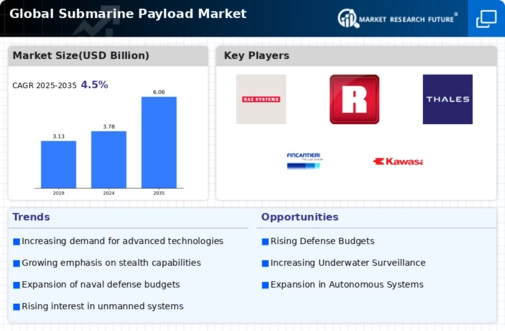Submarine Payload Size
Submarine Payload Market Growth Projections and Opportunities
The Submarine Payload market is shaped by dynamic factors that reflect the evolving landscape of naval capabilities and strategic maritime operations. One key market dynamic is the increasing focus on undersea warfare and the need for advanced submarine capabilities. As nations seek to enhance their maritime security and maintain a competitive edge, the demand for sophisticated submarine payloads, including sensors, torpedoes, and communication systems, experiences significant growth. The evolving threat landscape in underwater environments propels the development and deployment of advanced payloads to ensure the effectiveness of submarines in various operational scenarios.
Technological advancements in sensor systems and communication technologies contribute substantially to the market dynamics of Submarine Payloads. Innovations in sonar technologies, advanced sensor suites, and underwater communication systems enhance the situational awareness of submarines, allowing them to operate more effectively in diverse environments. The integration of cutting-edge technologies in submarine payloads aligns with the imperative of achieving dominance in undersea warfare and addresses the challenges posed by emerging threats.
Geopolitical considerations and regional tensions play a crucial role in shaping the market dynamics of Submarine Payloads. Nations with strategic maritime interests invest in enhancing the capabilities of their submarine fleets to safeguard maritime borders and project power in contested waters. The geopolitical landscape influences procurement decisions, leading to increased demand for advanced submarine payloads that offer superior detection, communication, and engagement capabilities, aligning with the strategic objectives of naval forces.
The rise in asymmetric threats and unconventional maritime challenges contributes to the dynamics of the Submarine Payload market. As non-state actors and rogue nations explore unconventional means to disrupt maritime security, the need for specialized submarine payloads designed for countermeasures, mine countermeasures, and intelligence, surveillance, and reconnaissance (ISR) becomes paramount. The adaptability of submarine payloads to address a spectrum of threats shapes the market, with a focus on developing versatile and multi-mission capabilities.
International collaborations and partnerships are significant dynamics in the Submarine Payload market. Given the complexity and cost of developing advanced submarine payloads, nations often engage in joint ventures, collaborative research, and technology-sharing agreements to pool resources and expertise. These collaborations contribute to the development of cutting-edge technologies and foster interoperability among allied navies, shaping the market dynamics and ensuring a collective approach to undersea warfare capabilities.
The modernization and replacement of aging submarine fleets worldwide are driving market dynamics in the Submarine Payload sector. As navies seek to upgrade their existing submarine platforms or invest in next-generation submarines, the demand for advanced payloads that offer improved performance, reduced lifecycle costs, and enhanced mission capabilities increases. The pursuit of modernization aligns with the overall goal of maintaining a credible and technologically superior submarine force.
The growing emphasis on unmanned underwater vehicles (UUVs) as part of submarine payloads is a notable dynamic in the market. UUVs serve as force multipliers, extending the reach and capabilities of submarines by conducting various missions, including reconnaissance, surveillance, and mine countermeasures. The integration of UUVs into submarine payloads reflects a shift toward leveraging autonomous technologies to enhance the effectiveness and versatility of undersea operations.
The increasing importance of data analytics and artificial intelligence (AI) in submarine operations contributes to market dynamics in Submarine Payloads. Advanced payloads are incorporating AI algorithms and data analytics capabilities to process vast amounts of sensor data, enhance decision-making processes, and improve overall mission effectiveness. The integration of smart technologies into submarine payloads reflects a broader trend toward leveraging data-driven insights in naval operations.
The market dynamics of Submarine Payloads are also influenced by considerations of cost-effectiveness and budget constraints. Nations seeking to enhance their submarine capabilities often evaluate the cost-benefit ratios of different payload systems, balancing the need for advanced features with fiscal responsibility. Manufacturers that can provide innovative and cost-effective solutions gain a competitive edge in the market, addressing the dynamic interplay between technological sophistication and budget considerations.









Leave a Comment